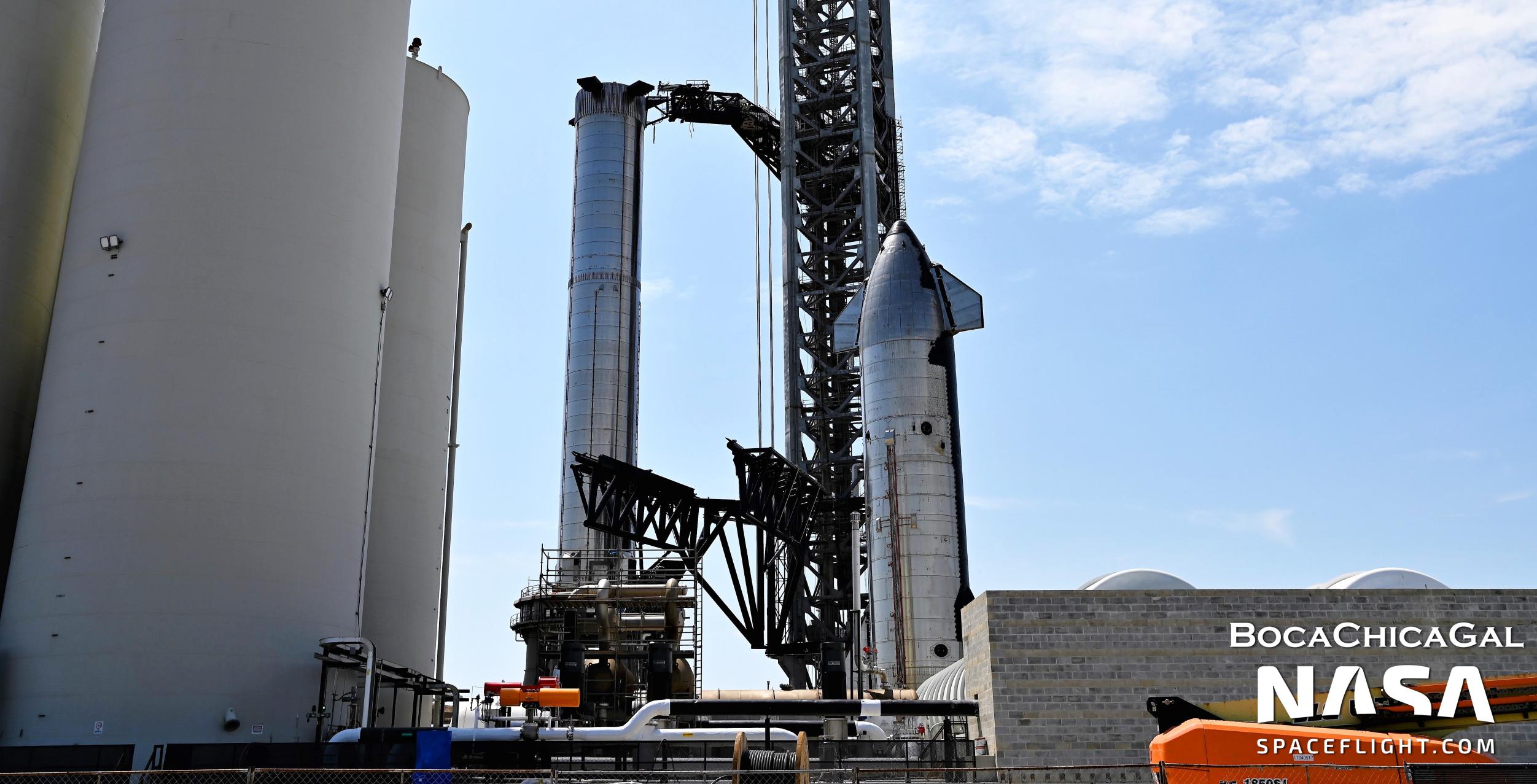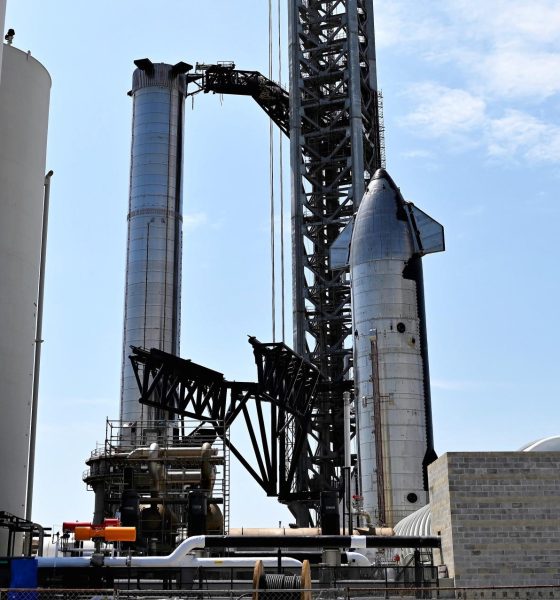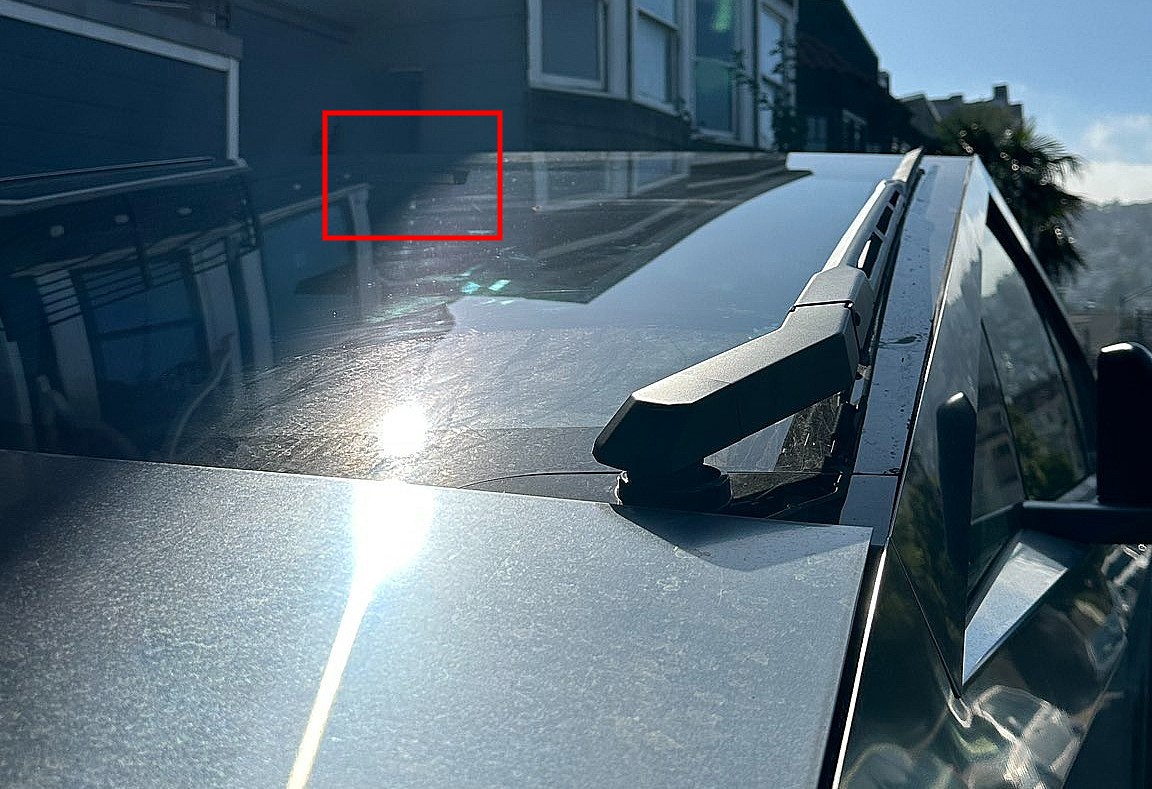

News
SpaceX destacks “420” Starship, Super Heavy pair for the third time
Update: Shortly before SpaceX CEO Elon Musk revealed that Super Heavy booster B4 and Starship S20 are no longer assigned to the rocket’s orbital launch debut, the company ‘destacked’ the pair for the third time.
Ship 20 was removed from Booster 4 on March 19th, two days before Musk’s tweets. That’s not unusual: it was actually Ship 20’s third removal from Super Heavy. However, almost as soon as the Starship was rolled out of the way, SpaceX began making visible preparations to also remove Super Heavy B4 from Starbase’s orbital launch mount. As of March 24th, the booster has been attached to a large crane for more than a day and a newly upgraded transport stand has been rolled into place beside the launch mount. It’s somewhat odd that the booster hasn’t already been removed but that step could happen at almost any moment, now – albeit likely in daylight.
Once both Ship 20 and Booster 4 have been removed, it’s hard to imagine that they will ever return to the orbital launch mount. In fact, at minimum, Super Heavy B4 will probably be retired almost immediately. Super Heavy B7 – a superior, refined, and upgraded prototype by almost every measure – is already almost fully assembled and could likely begin basic testing within a week or two.
SpaceX CEO Elon Musk says that Super Heavy Booster B4 and Starship S20 are no longer scheduled to support the first orbital-class test flight of the world’s largest rocket.
Rumors, signs, and reports of the significant change have been flowing among unofficial spaceflight communities for months. Booster 4 and Ship 20 were first confirmed by Elon Musk to be the pair assigned to Starship’s orbital test flight (OTF) in the summer of 2021. When the pair first rolled out to the launch pad in early August, Musk seemed confident that they could be ready for an orbital launch attempt within a month or two. The same was true in November 2021, when Musk stated that the same Starship and Super Heavy pair could be ready for their first launch as early as January or February 2022.
Musk’s latest update on Starship’s orbital test flight continues that schedule optimism but also introduces several major changes – changes that could easily take several months to fully work through.
Crucially, Musk revealed that the first Starship to attempt an orbital-class launch will now feature upgraded Raptor V2 engines – engines that require an entirely new thrust structure design. That already all but guaranteed that B4 and S20 had been overtaken but Musk also explicitly confirmed that they would be replaced with a new pair in a later tweet.
That new pair – widely assumed to be Super Heavy B7 and Starship S24 – feature a wide range of design changes, including substantially modified header tanks, an entirely new nosecone design, new layouts for secondary systems (pressurization, avionics, heat exchangers, etc.), and more. Most importantly, their thrust structures – giant ‘pucks’ machined out of steel – have been tweaked to support new Raptor V2 engines instead of the Raptor V1 and V1.5 engines that have been installed and tested on all Starship and Super Heavy prototypes to date.
Musk believes that SpaceX will be able to build (and presumably qualify) all 39 of the Raptors Ship 24 and Booster 7 will need before the end of April and fully install them – as well as all the heat shield components that must be fitted around them – by the end of May 2022. It’s unclear if the SpaceX CEO is accounting for the extensive proof testing Ship 24 and Booster 7 will likely need to complete before being qualified for flight, including cryogenic proof tests, wet dress rehearsals, and at least a few static fire tests.
In fact, SpaceX has only performed a single three-engine static fire test with a fully outdated Super Heavy prototype. Before the company is confident in its booster design, it’s practically a certainty that one or more prototypes will be put through a lengthy test campaign that gradually evolves from igniting a few engines to igniting all 29 or 33 Raptors. That may actually be one of the reasons SpaceX appears to be retiring Booster 4 without a single static fire or flight test – performing all the requisite work may have ultimately been perceived as a dead-end when every future Starship and Super Heavy prototype will feature a heavily redesigned engine.
This is to say that much like Musk’s last few Starship OTF schedule estimates, May 2022 also appears to be extremely optimistic. Booster 7 could potentially be ready for cryogenic proof testing any day now but Ship 24 is still in five large pieces and probably at least a month from any form of test readiness. Still, there are some reasons for optimism. If Booster 7 actually does start basic proof testing this month or early next without waiting for its Raptor engines or for heat shield installation, SpaceX could theoretically complete cryoproofing, begin installing one or a few new Raptors at a time, and iteratively progress from static firing a few to all 33 engines as the engines are arriving at Starbase.
At a minimum, even if that razor-sharp test schedule isn’t possible, Booster 7 would at least have a month or so of extra testing over Ship 24, minimizing the disproportionate amount of testing each prototype will likely need to be qualified for flight. Unlike Booster 4, Ship 20 has completed several static fires and cryoproofs without any apparent issue.
For now, SpaceX continues to prepare Ship 24 sections for stacking and appears to be buttoning up Booster 7, which could easily be ready to roll out for basic testing within a few weeks – and maybe sooner.

News
Tesla aims to combat common Full Self-Driving problem with new patent
Tesla writes in the patent that its autonomous and semi-autonomous vehicles are heavily reliant on camera systems to navigate and interact with their environment.

Tesla is aiming to combat a common Full Self-Driving problem with a new patent.
One issue with Tesla’s vision-based approach is that sunlight glare can become a troublesome element of everyday travel. Full Self-Driving is certainly an amazing technology, but there are still things Tesla is aiming to figure out with its development.
Unfortunately, it is extremely difficult to get around this issue, and even humans need ways to combat it when they’re driving, as we commonly use sunglasses or sun visors to give us better visibility.
Cameras obviously do not have these ways to fight sunglare, but a new patent Tesla recently had published aims to fight this through a “glare shield.”
Tesla writes in the patent that its autonomous and semi-autonomous vehicles are heavily reliant on camera systems to navigate and interact with their environment.

The ability to see surroundings is crucial for accurate performance, and glare is one element of interference that has yet to be confronted.
Tesla described the patent, which will utilize “a textured surface composed of an array of micro-cones, or cone-shaped formations, which serve to scatter incident light in various directions, thereby reducing glare and improving camera vision.”

The patent was first spotted by Not a Tesla App.
The design of the micro-cones is the first element of the puzzle to fight the excess glare. The patent says they are “optimized in size, angle, and orientation to minimize Total Hemispherical Reflectance (THR) and reflection penalty, enhancing the camera’s ability to accurately interpret visual data.”
Additionally, there is an electromechanical system for dynamic orientation adjustment, which will allow the micro-cones to move based on the angle of external light sources.
This is not the only thing Tesla is mulling to resolve issues with sunlight glare, as it has also worked on two other ways to combat the problem. One thing the company has discussed is a direct photon count.
CEO Elon Musk said during the Q2 Earnings Call:
“We use an approach which is direct photon count. When you see a processed image, so the image that goes from the sort of photon counter — the silicon photon counter — that then goes through a digital signal processor or image signal processor, that’s normally what happens. And then the image that you see looks all washed out, because if you point the camera at the sun, the post-processing of the photon counting washes things out.”
Future Hardware iterations, like Hardware 5 and Hardware 6, could also integrate better solutions for the sunglare issue, such as neutral density filters or heated lenses, aiming to solve glare more effectively.
Elon Musk
Delaware Supreme Court reinstates Elon Musk’s 2018 Tesla CEO pay package
The unanimous decision criticized the prior total rescission as “improper and inequitable,” arguing that it left Musk uncompensated for six years of transformative leadership at Tesla.

The Delaware Supreme Court has overturned a lower court ruling, reinstating Elon Musk’s 2018 compensation package originally valued at $56 billion but now worth approximately $139 billion due to Tesla’s soaring stock price.
The unanimous decision criticized the prior total rescission as “improper and inequitable,” arguing that it left Musk uncompensated for six years of transformative leadership at Tesla. Musk quickly celebrated the outcome on X, stating that he felt “vindicated.” He also shared his gratitude to TSLA shareholders.
Delaware Supreme Court makes a decision
In a 49-page ruling Friday, the Delaware Supreme Court reversed Chancellor Kathaleen McCormick’s 2024 decision that voided the 2018 package over alleged board conflicts and inadequate shareholder disclosures. The high court acknowledged varying views on liability but agreed rescission was excessive, stating it “leaves Musk uncompensated for his time and efforts over a period of six years.”
The 2018 plan granted Musk options on about 304 million shares upon hitting aggressive milestones, all of which were achieved ahead of time. Shareholders overwhelmingly approved it initially in 2018 and ratified it once again in 2024 after the Delaware lower court struck it down. The case against Musk’s 2018 pay package was filed by plaintiff Richard Tornetta, who held just nine shares when the compensation plan was approved.
A hard-fought victory
As noted in a Reuters report, Tesla’s win avoids a potential $26 billion earnings hit from replacing the award at current prices. Tesla, now Texas-incorporated, had hedged with interim plans, including a November 2025 shareholder-approved package potentially worth $878 billion tied to Robotaxi and Optimus goals and other extremely aggressive operational milestones.
The saga surrounding Elon Musk’s 2018 pay package ultimately damaged Delaware’s corporate appeal, prompting a number of high-profile firms, such as Dropbox, Roblox, Trade Desk, and Coinbase, to follow Tesla’s exodus out of the state. What added more fuel to the issue was the fact that Tornetta’s legal team, following the lower court’s 2024 decision, demanded a fee request of more than $5.1 billion worth of TSLA stock, which was equal to an hourly rate of over $200,000.
Delaware Supreme Court Elon Musk 2018 Pay Package by Simon Alvarez
News
Tesla Cybercab tests are going on overdrive with production-ready units
Tesla is ramping its real-world tests of the Cybercab, with multiple sightings of the vehicle being reported across social media this week.

Tesla is ramping its real-world tests of the Cybercab, with multiple sightings of the autonomous two-seater being reported across social media this week. Based on videos of the vehicle that have been shared online, it appears that Cybercab tests are underway across multiple states.
Recent Cybercab sightings
Reports of Cybercab tests have ramped this week, with a vehicle that looked like a production-ready prototype being spotted at Apple’s Visitor Center in California. The vehicle in this sighting was interesting as it was equipped with a steering wheel. The vehicle also featured some changes to the design of its brake lights.
The Cybercab was also filmed testing at the Fremont factory’s test track, which also seemed to involve a vehicle that looked production-ready. This also seemed to be the case for a Cybercab that was spotted in Austin, Texas, which happened to be undergoing real-world tests. Overall, these sightings suggest that Cybercab testing is fully underway, and the vehicle is really moving towards production.
Production design all but finalized?
Recently, a near-production-ready Cybercab was showcased at Tesla’s Santana Row showroom in San Jose. The vehicle was equipped with frameless windows, dual windshield wipers, powered butterfly door struts, an extended front splitter, an updated lightbar, new wheel covers, and a license plate bracket. Interior updates include redesigned dash/door panels, refined seats with center cupholders, updated carpet, and what appeared to be improved legroom.
There seems to be a pretty good chance that the Cybercab’s design has been all but finalized, at least considering Elon Musk’s comments at the 2025 Annual Shareholder Meeting. During the event, Musk confirmed that the vehicle will enter production around April 2026, and its production targets will be quite ambitious.








